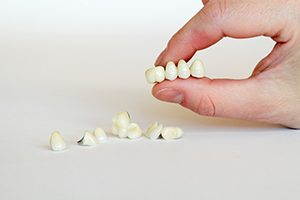 Dental Crowns to Repair Damaged Teeth
Dental Crowns to Repair Damaged Teeth
Most dentists will agree that crown restorations are at the heart of general dentistry. We’ve all studied crowns in dental school, and some of us have done our best work using crowns to repair a damaged or decayed tooth.
Modern materials give us the ability to create virtually ideal restorations, and all-porcelain crowns are natural looking, comfortable, and stable in the moist environment of the mouth. We’re better equipped than ever to build strong, long-lasting and cosmetically superior crowns. Contact us today to schedule an appointment or consultation on dental crowns.
What is a crown?
A crown (or cap) is a restoration placed over a broken tooth that cannot sustain a conventional filling. By covering the biting surfaces and sides of the tooth, a crown strengthens the damaged tooth by binding together the remaining structure.
There are basically three kinds of full-crown restorations, each with pros and cons, depending on your situation.
- All porcelain crowns have become the more popular because of their beautiful and natural crowns—and their new ceramic cousins—look wonderful and fit well, but are usually best on front teeth where stress is not so great.
- Porcelain-fused-to-metal crowns implement a hybrid of materials to provide strong and aesthetic restorations.
- Metal crowns are made of gold or alloys. They have a great track record for durability, however some people object to their unnatural appearance.
There is a certain art that goes into the creation of any crown. The fit is the thing. The crown must be prepared with opposing teeth in mind, so that a proper bite is maintained after the crown is placed. The fit must accommodate adjacent teeth, too. And the “margin” (the part of the crown nearest the gum) must fit smoothly to protect the health of gum tissue.
And all this effort is to one end: to save a tooth!
When Do I Need a Crown?
- When a tooth that has been filled more than once cracks, breaks off, or falls victim to secondary caries—a cavity under or around a filling.
- To strengthen a tooth that has had root canal therapy.
- When a tooth has suffered severe enamel wear.
- When a tooth has suffered trauma and fractured.
- To help support your new dental bridge.
